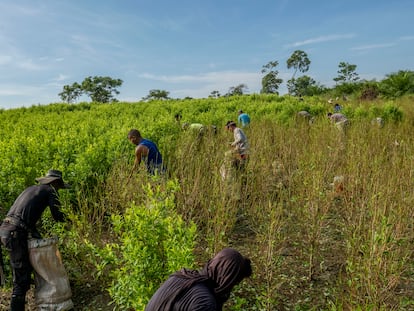Colombia’s forests, silent victims of the war on drugs
It’s not just cocaine production that is bad for the environment. The war on drugs has an even greater impact on Colombian ecosystems
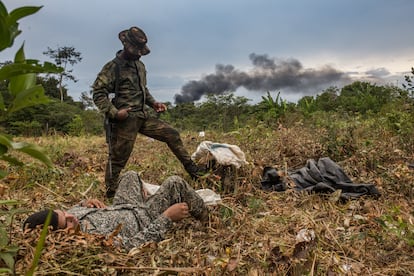
On a sweltering Tuesday morning, a Vietnam War-era helicopter filled with judicial police officers and military explosives experts lifts into the sky above the Amazonian backwater town of San José del Guaviare, Colombia.
As it flies south, the mosaic of cattle pastures crisscrossed by red clay roads dissolves into patches of jungle disfigured by fresh deforestation. This is the Amazon frontier: a vague and constantly progressing delimitation between humankind and the wild. From the sky, the jungle seems infinite and paradisiacal. But the tensions that exist below are soon revealed in the form of iridescent green scars: patches of Erythroxylum coca, an innocuous-looking shrub whose leaves are the raw material for cocaine.
In the distance, a spindly smoke signal marks the point where the helicopter’s passengers wound disembark for a routine mission: the destruction of a cocaine laboratory hidden in the surrounding forest. It’s here, in one of the most biodiverse ecosystems on Earth, where the front lines of the war on drugs can be found.
Despite decades of economic and military support from the United States--ironically both the world’s largest consumer of cocaine and the largest bankroller of the war on drugs--Colombia continues to lead global cocaine production, accounting for nearly 70% of the world’s supply. Years of prohibitionist policies have not achieved the promised reductions in coca and cocaine in Colombia. In fact, in the last few years, the country has produced more cocaine than at any other moment in history. Despite the clear failings of existing policies, the US government continues to insist on advancing this war, even in the face of opposition from Colombian President Gustavo Petro.
For those concerned about the integrity of Colombia’s forests, the intention to continue the use of forced eradication policies is bad news. Today, a growing body of scientific and empirical evidence shows that anti-drug policies aren’t just ineffective at stopping cocaine production--they are responsible for severe, often irreparable environmental degradation in some of the planet’s most important biodiversity hotspots.
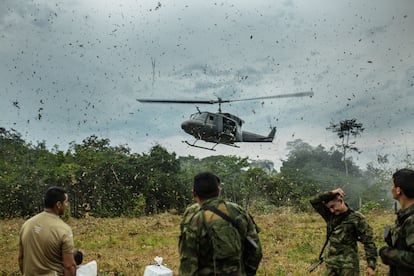
The coca-deforestation nexus
When Dr. Liliana M. Dávalos, a conservation biologist at Stony Brook University, began researching the connection between deforestation and coca in the 1990s, she believed that eliminating coca would result in greater environmental protection. But as new satellite technology emerged and scientific studies evolved, the connection between coca and deforestation grew weaker and weaker.
Now, there is no evidence to show that coca is the main driver of deforestation in Colombia. Instead, scientists have found the opposite: rather than protecting forests, forced eradication programs increase habitat loss, driving coca growers into ever more remote regions.
Like a perpetual game of whack-a-mole, more than half of Colombia’s coca crop is eradicated each year, only to reappear elsewhere in a pattern known as the “balloon effect”: squeeze a balloon, and the air doesn’t disappear--it simply bulges into a different area.
Over the years, eradication has pushed coca into 23 of Colombia’s 32 departments, carving paths of destruction through the planet’s most important ecosystems, including National Parks, collective territories of Afro communities, indigenous reservations and forest reserves. According to the 2021 report from the United Nations Office on Drugs and Crime (UNODC), these areas, established with environmental protection in mind, collectively harbored more than 50% of all coca grown in Colombia.
As coca has taken root in these areas, so too have armed groups, whose presence destabilizes and prevents existing environmental policies from succeeding. Meanwhile, profits from drug trafficking, inflated by illegality, are laundered through legal economic activities such as cattle ranching and agribusiness. Ironically, says Dávalos, these activities entail much more serious environmental impacts than coca. “The bulk of deforestation is occurring from land grabbing, from the conversion of forests into cattle pasture,” she says. “Not from coca.”
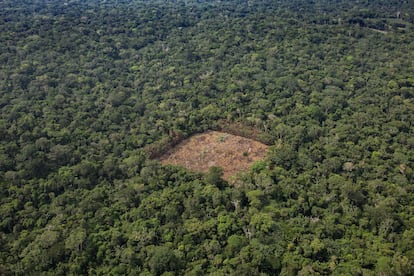
Following family tradition, Eladio Cruz (whose name has been changed to protect his identity) has dedicated his life to growing coca. He produces cocaine paste in southern Colombia, close to the border with Ecuador. On the walls of a small school near his house, the letters “FARC-EP” are scrawled in faded red paint. Above, large black letters spell out, “COMANDOS DE LA FRONTERA” (Border Commandos). On one of the visits to the area at the end of 2020, the paint was still fresh--a mark left by the latest armed group to have taken control of the cocaine economy in this Amazonian region.
Cruz is shoveling fresh coca leaves into a large black tank when two monkeys wander down from the canopy to peer beneath the tarp covering the rudimentary production site. “They come by here every day to see us,” he says with a smile.
When asked about the potential environmental impacts of his trade, such as the improper disposal of chemicals into the jungle during the production of cocaine paste, Cruz initially responds with a blank stare.
“You have to understand that this is a business,” he replies. “These chemicals cost money. They’re illegal, controlled substances, so we have to pay bribes to get them, and then we have to pay someone to bring them all the way out here,” he explains, gesturing towards the jungle that envelops us.
“Plus,” he continues, “we can reuse them.” Cruz lifts the lid off a barrel of gasoline, used as a solvent to release the psychoactive molecules from the coca leaf. The liquid is dark, emerald green. The color, he explains, comes from using this same gasoline over and over again in the production of cocaine paste. “Why would we throw away something that we can reuse?” he asks with a laugh. “Look at me,” he says, gesturing to his threadbare clothes. He is standing atop a pile of coca leaves, arms outstretched, with a shovel in his hand. With his free hand, he swats at a fly buzzing around his head. “Do I look like I can afford to be dumping this stuff out?”
A closed cycle
In the ‘cottage industry’ of cocaine paste production, fresh coca leaves are processed into a crude extract using an artisanal process requiring little infrastructure or knowledge of chemistry. The crystallization of cocaine paste into cocaine hydrochloride (the white powder), on the other hand, is much more sophisticated, requiring advanced chemical and engineering expertise, complex laboratory equipment, and a more extensive range of precursor chemicals.

Few places on Earth lend themselves so perfectly to this clandestine process as do the entrails of the Colombian Amazon, where the forest functions as an invisibility cloak. It’s here, at an undisclosed point deep in the jungles of Guaviare, where the helicopter descends in May 2019 for the agents to disembark in a small clearing. From the edge of the clearing, a band of unshaven, heavily armed soldiers emerges. The platoon, which had been patrolling the densely forested area for months, had been sent to provide security for the agents in charge of destroying the massive crystallization laboratory discovered nearby.
According to official records, the laboratory is among the largest found in the history of Guaviare, capable of producing about four tons of cocaine hydrochloride per month. As the team collects samples and measurements, the senior agent explains the uses of the different supplies and pieces of equipment. When he approaches a huge stainless steel tank connected by a series of tubes to a Jacuzzi-sized tub, he stops.
This, he explains, is one of the most important pieces of equipment in any crystallization laboratory: a distillation system, used for recycling precursor chemicals. In doing so, the owners of this operation are able to reduce production costs and while also limiting the risk of exposing the laboratory’s location by the movement of supplies to the remote site.
According to the agents, while this lab was operational, the solvents--the chemicals most hazardous to the environment--would have been used and recycled in a closed system producing little waste other than marginal losses to evaporation.
That day, investigators discovered almost a ton of solid chemicals and more than 1,000 gallons of hydrocarbons stashed throughout the complex. As is often the case during these kinds of anti-narcotics operations, many of the chemicals are heaped into a pile to be burned. Others are dumped, often alongside the rivers or streams that serve as in-roads to these remote sites.
Héctor Hernando Bernal Contreras, a UNODC expert in precursor chemicals, says that although there are detailed guidelines for the safe disposal of chemicals used in the illicit manufacture of drugs, these are only recommendations, not legally-binding rules. While following these guidelines would help reduce the collateral damage inflicted upon the environment during anti-drug operations, since the vast majority of seizures are made in extremely remote locations with high security risks, they are rarely applied.
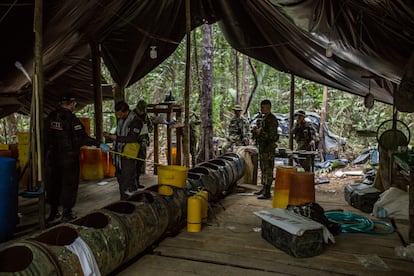
On the ground, in the laboratory in Guaviare, the abstract threat of environmental damage seems inconsequential when compared to the very real possibility of an ambush by armed groups. Between torrential downpours, oppressive heat, and clouds of mosquitoes, the agents work carefully, aware that anything they touch may be connected to an explosive device left to maim officers like them. As soon as the last sample is collected, the soldiers turn their weapons to their backs and begin to destroy the compound and everything in it.
More than 16,000 laboratories destroyed in a decade
Because security risks prevent scientists from entering these areas to study them--even after they have been destroyed--the environmental impacts of these operations are unknown. However, the probability of thousands of miniature Superfund sites hidden in these jungles becomes more tangible considering that, according to data from the National Police, more than 16,000 laboratories have been destroyed, just in the past 10 years (not including those destroyed by the military).
According to records provided by the Colombian Anti-Narcotics Police, between 2010 and 2020, these operations resulted in the disposal of more than 304 million kilograms of solids and 42 million gallons of liquid chemical precursors. These figures include several substances that precursor chemicals expert Bernal Contreras identifies as the most dangerous for the environment: hydrochloric acid (208,112 gallons), sulfuric acid (752,912 gallons), toluene (475,127 gallons) and potassium permanganate (817,444 kilograms).
As scientific evidence illuminates the environmental impacts generated not just by cocaine production, but also by the policies used to combat coca and cocaine, the historically inelastic issue of drug policy is beginning to open up to the possibility of reform. In 2020, Colombian senators presented the first bill to legalize coca crops in Colombia, something that even a few years ago would have seemed unthinkable.
In the meantime, Pedro Arenas, a former Colombian congressman and member of the International Drug Policy Consortium, suggests that land reform and greater government commitment to voluntary crop substitution programs would be a good start. What we shouldn’t do, he warns, is continue applying the same prohibitionist policies that we’ve used over the past decades.
For Dávalos, the fact that forced eradication is still on the table is a sign that there is a long way to go to reach the necessary policy reform. “At some point you have to talk about the definition of insanity,” she says with an exhausted laugh. “You do the same thing over and over again and expect a different result. What is that?”

As a conservation biologist, her greatest concern is ensuring the health of Colombia’s forests. In order to do so, she suggests we detach from the sense of moralism that has historically driven our thinking about drug policy. Instead, she says, we should focus on deepening our understanding of the social, economic and political factors that continue to drive colonization in the Colombian Amazon, and question the kinds of logic that continues to favor economic development over conservation.
Tu suscripción se está usando en otro dispositivo
¿Quieres añadir otro usuario a tu suscripción?
Si continúas leyendo en este dispositivo, no se podrá leer en el otro.
FlechaTu suscripción se está usando en otro dispositivo y solo puedes acceder a EL PAÍS desde un dispositivo a la vez.
Si quieres compartir tu cuenta, cambia tu suscripción a la modalidad Premium, así podrás añadir otro usuario. Cada uno accederá con su propia cuenta de email, lo que os permitirá personalizar vuestra experiencia en EL PAÍS.
¿Tienes una suscripción de empresa? Accede aquí para contratar más cuentas.
En el caso de no saber quién está usando tu cuenta, te recomendamos cambiar tu contraseña aquí.
Si decides continuar compartiendo tu cuenta, este mensaje se mostrará en tu dispositivo y en el de la otra persona que está usando tu cuenta de forma indefinida, afectando a tu experiencia de lectura. Puedes consultar aquí los términos y condiciones de la suscripción digital.
More information
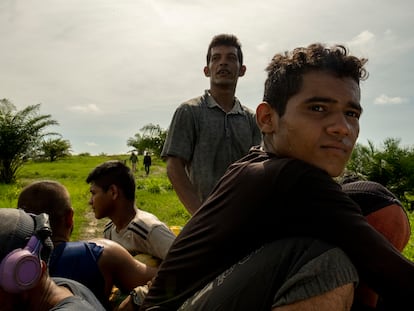
Picking coca leaves in Colombia: The thankless job that Venezuelans are doing
